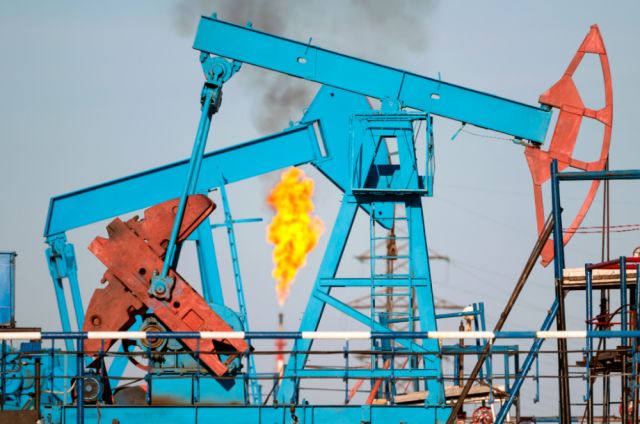
(Source: Leonid Ikan/Shutterstock.com)
New Mexico oil industry regulators took a leap toward reducing emissions in the state, adopting rules that require operators, both upstream and midstream, to capture 98% of natural gas waste by year-end 2026 among other requirements.
The unanimous action by New Mexico’s Oil Conservation Commission came March 25 after about two years spent gathering public comments, listening to testimony from stakeholders and conducting technical research in hopes of ending the practice of routine venting and flaring of natural gas in the state.
“The 98 percent capture is an ambitious target that will secure significant methane waste reductions that will directly benefit New Mexico’s environment,” Sarah Cottrell Propst, cabinet secretary for New Mexico’s Energy, Minerals and Natural Resources Department (EMNRD), said in a statement. “Oil and gas operations make up the biggest portion of greenhouse gas emissions in New Mexico, and the rules established today will lead to reductions across the board beginning in 2022.”
The move comes amid heightened global focus on climate change and investor pressure on oil companies to shrink carbon footprints. New Mexico, which is home to part of the prolific Permian Basin, saw the amount of flared and vented natural gas increase in recent years as producers targeted more oil.
Data released in January by Rystad Energy show New Mexico’s Delaware North was the only major Permian sub-basin to see flaring rise late last year, unlike other shale plays across the U.S. recovering from the demand slowdown driven by the global coronavirus pandemic.
Though the area had the lowest flaring intensity compared to other major sub-basins in the play at the time, it had more activity than other parts of the play, according to Rystad.
In 2019, an estimated 36 Bcf of natural gas was vented and flared by operators in New Mexico based on data from the New Mexico Oil Conservation Division (OCD).
The amount of gas flared or vented across the entire Permian Basin, however, has been falling.
New Mexico’s regulatory changes apply not only to the upstream sector but also to gas processing plants and pipeline operators.
For operators, if gas capture targets aren’t hit, the state may deny drilling permits.
As explained by the EMNRD, changes include requirements for natural gas capture and flaring for completion and recompletion of natural gas wells to reduce natural gas venting. If a gathering system is unavailable, operators must select and use alternative beneficial uses for natural gas. Any new facilities must also be constructed in a way that minimizes waste.
The first phase of New Mexico’s natural gas waste rule kicks off a natural gas loss reporting program. Data collected during this phase will be used to establish enforceable targets, as part of Phase 2, for operators to lower natural gas waste, according to the EMNRD.
“Starting from the level of natural gas waste identified in Phase 1, Phase 2 begins in 2022 and requires operators to reduce their waste by a fixed amount each year to achieve a gas capture rate of 98% by December 31, 2026,” the department said.
The OCD called the requirements one of the strongest in the nation. North Dakota’s rule has a gas capture rate of 91%, while Colorado and Oklahoma have no capture percentage with each tracking gas capture differently.
New Mexico said its rule, like Colorado’s, also prohibits routine flaring. Of the four states, only New Mexico rules curtail production for not hitting targets. It is also the only one of the four whose rules apply to gas gathering pipelines and midstream operations.
“The finalization of today’s rules proves that taking bold action on climate change is not at odds with industry and job creation,” New Mexico Gov. Michelle Lujan Grisham said March 25. “By working together, we have come up with rules that require a higher gas capture than any other state in the nation and that will foster innovation and bring additional revenue to the state by capturing more resources.”
The New Mexico Oil & Gas Associated commended the commission for its collaboration.
“We will strive for full compliance with the final rule, and we commend this commission for undertaking a collaborative approach throughout this two-year process,” Robert McIntyre, a spokesman for the New Mexico Oil & Gas Association, told Bloomberg.
The Environmental Defense Fund estimates that New Mexico wastes $271 million worth of natural gas annually and misses $43 million more that could have come its way in annual tax and royalty revenue.
“The Lujan Grisham administration deserves praise for enacting strong rules to end routine venting and flaring in New Mexico,” said Jon Goldstein, director of energy regulatory and legislative affairs for EDF. “This is a first and critical step toward addressing the 1.1 million metric tons of methane pollution from the oil and gas industry.”
Recommended Reading
E&P Highlights: April 22, 2024
2024-04-22 - Here’s a roundup of the latest E&P headlines, including a standardization MoU and new contract awards.
Oceaneering Won $200MM in Manufactured Products Contracts in Q4 2023
2024-02-05 - The revenues from Oceaneering International’s manufactured products contracts range in value from less than $10 million to greater than $100 million.
E&P Highlights: Feb. 5, 2024
2024-02-05 - Here’s a roundup of the latest E&P headlines, including an update on Enauta’s Atlanta Phase 1 project.
CNOOC’s Suizhong 36-1/Luda 5-2 Starts Production Offshore China
2024-02-05 - CNOOC plans 118 development wells in the shallow water project in the Bohai Sea — the largest secondary development and adjustment project offshore China.
TotalEnergies Starts Production at Akpo West Offshore Nigeria
2024-02-07 - Subsea tieback expected to add 14,000 bbl/d of condensate by mid-year, and up to 4 MMcm/d of gas by 2028.






